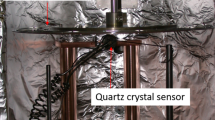Abstract
The FAIR-PANDA target complex is currently based on two types of targets, a cluster cryogenic target and a cryogenic monodisperse target. Both types of targets in experiments with hydrogen and its isotopes, as well as in experiments with heavier gases, are able to provide a required density of matter at the point of interaction with a beam. The advantages of a cryogenic monodisperse target are the possibility of operation in both the high resolution (PTR) and high luminosity (PTH) modes, the absence of leakage into the interaction chamber, and the possibility of a precise reconstruction for the process of interaction with a beam. These advantages, in our opinion, make this target more promising for the PANDA physical programs. The important goals attained as a result of studies on the prospects for the further development of monodisperse targets are as follows: the possibility of creating high-speed monodisperse targets of small diameter from different cryogenic liquids with a speed of target introduction into a beam >100 m/s alongside supercold cryogenic targets has been shown.



Similar content being viewed by others
REFERENCES
V. E. Fortov, B. Yu. Sharkov, and Kh. Shtoker, “European Facility for Antiproton and Ion Research (FAIR): the new international center for fundamental physics and its research program,” Phys. Usp. 55, 582–602 (2012).
A. N. Vasiliev, A. V. Boukharov, D. A. Morozov, et al., “Search for new forms of matter in antimatter-matter interactions in the PANDA experiment,” At. Energy 112, 129–138 (2012).
Panda Collab., “The cluster-jet target and development for the pellet target/Panda,” Target TDR (2012).
A. Khoukaz, “Internal targets for the PANDA experiment,” in Proceedings of STORI’11 Conference (2012). https://doi.org/10.22323/1.150.0036
E. Köhler, D. Bonaventura, A. K. Hergemöller, et al., “Design and performance of the future cluster-jet target for PANDA at FAIR,” in Proceedings of STORI’11 Conference (2012). https://doi.org/10.22323/1.150.0063.
Lord Rayleigh, “On the instability of a cylinder of viscous liquid under capillary force,” Phil. Mag. 34, 145–154 (1892).
B. Trostell, “Vacuum injection of hydrogen micro-sphere beams,” Nucl. Instrum. Methods Phys. Res., Sect. A 362, 41–52 (1995).
A. V. Bukharov, A. F. Ginevskii, V. P. Chernyshev, et al., “Cryogenic corpuscular targets. Concepts and the basic model,” Preprint No. 17-17 (Mosk. Energ. Inst., Moscow, 2002).
A. Boukharov, M. Buscher, V. Balanutsa, et al., “Dynamics of cryogenic jets: non-Rayleigh breakup and onset of nonaxisymmetric motions,” Phys. Rev. Lett. 100, 174505–1 (2008).
A. V. Bukharov, V. P. Chernyshev, V. D. Chernetskii, and M. Byusher, RF Patent No. 2298890, Byull. Izobret., No. 13 (2007).
A. V. Boukharov and M. Buscher, “Verfahren und Vorrichtung zur Kuihlung eines Gases,” German patent application No. 10 2007017, 7–13.
A. V. Boukharov, A. F. Ginevskii, V. P. Chernyshev, et al., “Cryogenic corpuscular targets. Generation of hydrogen pellets: calculation of main structural elements, experimental stand, tests,” Preprint No. 9-05 (Inst. Teor. Eksp. Fiz., Moscow, 2005).
A. Boukharov, M. Buescher, et al., “Status of the granulated target for the PANDA experiment,” Annual Report 2008 (Highlights), Institut für Kernphysik, Berichte des Forschungszentrums Jülich, Jül-4282 (2009).
A. V. Boukharov, E. V. Ametistov, A. F. Ginevsky, and M. A. Bukharova, “Heat-physical problems of cryogenic corpuscular targets,” Problems At. Sci. Tech. Ser. Nucl. Phys. Res. No. 6, 205–208 (2013).
A. V. Bukharov, M. Byusher, A. S. Gerasimov, and A. F. Ginevskii, “Use of the cryogenic corpuscular target for experiments on laser acceleration of charged particles,” Vopr. At. Nauki Tekh. Ser. Yad.-Fiz. Issl. No. 2, 60—63 (2010).
A. Boukharov and E. Vishnevkii, “High speed cryogenic monodisperse targets for high intensity cyclic and linear accelerators,” in Proceedings of RuPAC2016 Conference, St. Petersburg, Russia, 2016, pp. 532–534.
V. B. Ankudinov, A. V. Boukharov, V. P. Ogorodnikov, and Y. A. Marukhin, “New type of metal targets,” Problems At. Sci. Tech. Ser. Nucl.-Phys. Res. No. 3, 190–192 (2014).
Author information
Authors and Affiliations
Corresponding author
Ethics declarations
The authors declare that they have no conflicts of interest.
Additional information
Translated by E. Glushachenkova
Rights and permissions
About this article
Cite this article
Bukharov, A.V., Bukharova, M.A. & Vishnevsky, E.V. Cryogenic Target Complex of the FAIR Accelerator and Prospects for Its Development. Phys. Part. Nuclei Lett. 20, 714–719 (2023). https://doi.org/10.1134/S1547477123040155
Received:
Revised:
Accepted:
Published:
Issue Date:
DOI: https://doi.org/10.1134/S1547477123040155



